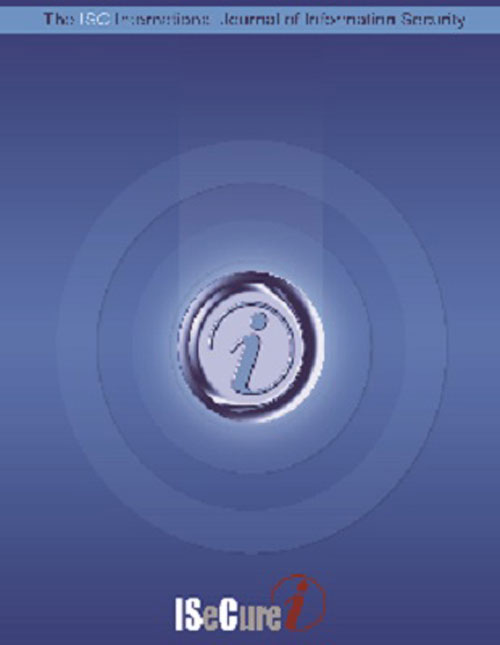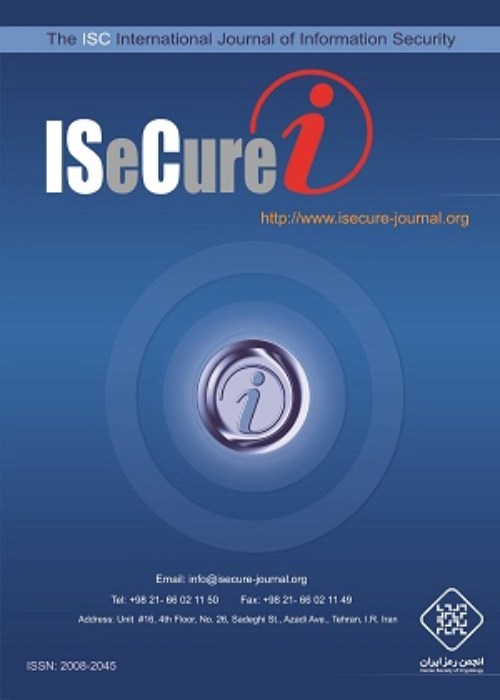فهرست مطالب

International Journal of Information Security
Volume:8 Issue: 2, Jul 2016
- تاریخ انتشار: 1395/11/30
- تعداد عناوین: 7
-
-
Pages 85-86
-
Pages 87-98Fab-less business model in semiconductor industry has led to serious concerns about trustworthy hardware. In untrusted foundries and manufacturing companies, submitted layout may be analyzed and reverse engineered to steal the information of a design or insert malicious Trojans. Understanding the netlist topology is the ultimate goal of the reverse engineering process. In this paper, we propose a netlist encryption mechanism to hide the interconnect topology inside an IC. Moreover, new special standard cells (Wire Scrambling cells) are designed to play the role of netlist encryption. Furthermore, a design ow is proposed to insert the WS-cells inside the netlist with the aim of maximum obfuscation and minimum overhead. It is worth noting that this mechanism is fully automated with no need to detail information of the functionality and structure of the design. Our proposed mechanism is implemented in an academic physical design framework (EduCAD). Experimental results show that reverse engineering can be hindered considerably in cost of negligible overheads by 23% in area, 3.25% in delay and 14.5% in total wire length. Reverse engineering is evaluated by brute-force attack, and the learned information is 0% and the Hamming distance is approximately 50%.Keywords: Hardware Security, Netlist Encryption, Obfuscation, Reverse Engineering, IP Piracy
-
Pages 99-109Radio Frequency Identification (RFID) applications have spread all over the world. In order to provide their security and privacy, researchers proposed different kinds of protocols. In this paper, we analyze the privacy of a new protocol, proposed by Yu-Jehn in 2015 which is based on Electronic Product Code Class1 Generation 2 (EPC C1 G2) standard. By applying the Ouafi_Phan privacy model, we show that the Yu-Jehn protocol is vulnerable to secret parameter reveal attack, traceability attacks, forward traceability attack and it also does not provide the privacy of RFID users. To enhance the privacy of the analyzed protocol, an improved version of the protocol is proposed which eliminates the existing weaknesses of Yu-Jehn protocol.Keywords: RFID Authentication Protocols, Privacy, Traceability Attack, Forward Traceability Attack, Ouafi-Phan Privacy Model
-
Pages 111-126Wireless sensor networks (WSNs) have many applications in the areas of commercial, military and environmental requirements. Regarding the deployment of low cost sensor nodes with restricted energy resources, these networks face a lot of security challenges. A basic approach for preparing a secure wireless communication in WSNs, is to propose an efficient cryptographic key management protocol between sensor nodes to achieve maximum security with minimum cost. The main motivation of this paper is to apply the position of the sensor nodes as part of their identity for key management in heterogeneous sensor networks. In the proposed scheme, the position of sensor nodes is considered as a part of their identity and it is used for authentication and dedicating key to all network links. Comparing the proposed technique with other schemes shows that it has a higher level of scalability, security, and reliability with less memory complexity.Keywords: WSN, Position Based Cryptography, Key Management, Heterogeneous Sensor Networks
-
Pages 127-135This paper investigates the multiplicative spread spectrum watermarking method for the image. The information bit is spreaded into middle-frequency Discrete Cosine Transform (DCT) coefficients of each block of an image using a generated pseudo-random sequence. Unlike the conventional signal modeling, we suppose that both signal and noise are distributed with Laplacian distribution, because the sample loss of digital media can be better modeled with this distribution than the Gaussian one. We derive the optimum decoder for the proposed embedding method thanks to the maximum likelihood decoding scheme. We also analyze our watermarking system in the presence of noise and provide analytical evaluations and several simulations. The results show that it has the suitable performance and transparency required for watermarking applications.Keywords: Laplacian Distribution, Maximum Likelihood Decoding, Spread Spectrum Method, Watermarking
-
Pages 137-149Quantitative and model-based prediction of security in the architecture design stage facilitates early detection of design faults hence reducing modification costs in subsequent stages of software life cycle. However, an important question arises with respect to the accuracy of input parameters. In practice, security parameters can rarely be estimated accurately due to the lack of sufficient knowledge. This inaccuracy is ignored in most of the existing evaluation methods. The aim of this paper is to explicitly consider parameter uncertainty in the software security evaluation process. In particular, we use the Dempster-Shafer theory of evidence to formulate the uncertainties in input parameters and determine their effects on output measures. In the proposed method, security attacks are expressed using UML diagrams (i.e., misuse case and mal-activity diagrams) and security parameters are specified using the SecAM profile. UML/SecAM models are then transformed into attack trees, which allow quantifying the probability of security breaches. The applicability of the method is validated by a case study on an online marketing system.Keywords: Software architecture, Security Evaluation, Uncertainty Quantification, Evidence Theory
-
Pages 151-157Recently, Baghery et al. [1, 2] presented some attacks on two RFID protocols, namely Yoon and Jung et al. protocols, and proposed the improved version of them. However, in this note, we show that the improved version of the Jung et al. protocol suffers from desynchronization attack and the improved version of the Yoon's protocol suffers from secret disclosure attack. The success probability of the desynchronization attack against the improved version of the Jung et al. protocol is (1-2-2n)2, where n is length of the protocol parameters. The attack can be accomplished with just three runs of the protocol. The success probability of the secret disclosure attack against the improved version of the Yoon's protocol is almost 1, while the complexity is just two runs of the protocol and doing 216 off-line evaluations of PRNG function.Keywords: RFID, Authentication Protocol, Desynchronization Attack, Secret Disclosure Attack


